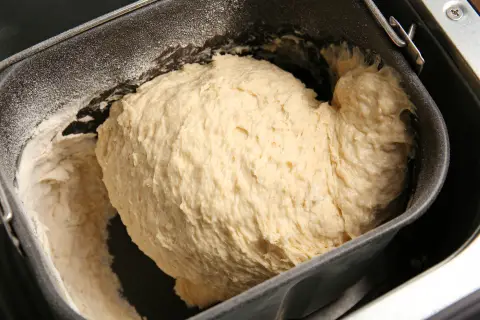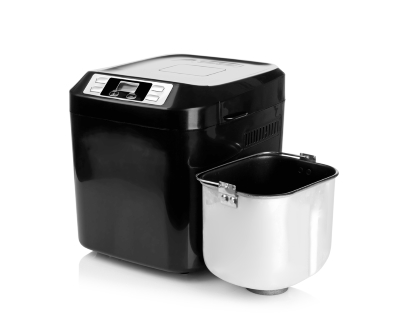If you have bought a new bread-making machine, you might be wondering, “Are bread makers noisy?” Simply put, no. Bread machines aren’t too noisy if they are functioning normally. Most of the noise will be produced when the machine is kneading the dough. However, you may hear some unusual noises, in which case, it is better to check the bread machine for maintenance.
Bread machines typically emit a beeping noise during different stages of making bread. However, if you hear any grinding or squeaking noises, that’s a cause for concern. Read on to find out more about bread makers and the noises they produce.
Table of Contents
Do Bread Makers Make a Lot of Noise?
Bread makers do not produce much noise apart from the usual ones when working. However, they do require regular maintenance and oiling. If not maintained, the mechanism of the bread machine will eventually wear down, requiring parts to be replaced or repaired to continue to work smoothly and not make a noise.
However, when the dough is being kneaded by the bread machine, there will always be some noise. While this noise is natural, it shouldn’t be too much; otherwise, it might be because of a problem.
Bread Machine Noises and How to Stop Them
Bread machines make different noises, each of them indicating something different. If you hear a grinding or a squeaking noise, you most likely need to lubricate the internal parts of the bread machine. Banging noises are produced when the dough is kneaded, which isn’t a huge problem and may just need you to fit the baking pan properly into its place inside the machine so that it doesn’t knock about during the kneading phase. Beeping noises are a functional part of the machine and can either be muted or muffled.

Bread Machine Grinding Noise
If your bread machine is producing a loud grinding noise, you should check the bread spindle shaft located beneath the bread pan. It may need cleaning and then lubrication with something like sewing machine oil or a 3-in-1 oil.
The first step to oiling the bread spindle shaft is to flip the pan over. Let a drop of oil fall between the bread spindle shaft and the retaining ring. Once done, you need to turn the wing nut repeatedly to make sure the oil gets down in all the parts.
Bread Machine Squeaking
In case your bread machine is squeaking, you may want to check the apparatus. Start by removing the bake pan and see if the connector in the base can turn easily. If the connector rotates stiffly, it will produce a squeaking noise.
All it needs is a little bit of lubrication but because this location is the inside of the bread pan, the oil you use has to be edible. Try putting some olive oil in the pan and let it drip down to the plastic bearing. If the noise persists, lubricate the base bearing too.
Bread Machine Knocking or Banging Noise
If you hear your bread machine produce a banging noise, there can be two reasons. Either the dough is too dry or stiff and is being rocked to and fro during the kneading process, or perhaps the ingredient vessel has loosened out of its place.
For the kneading process, you may want to use lighter or less stiff dough, which means adding in a little water. For the loosening of the pan, you will simply have to push it down and make sure it is securely in place.
Why Does My Bread Maker Beep?
Switching the Bread Machine On
For those unaware, turning on the bread machine will emit a beeping noise. Some people do confuse it as being indicative of a problem. However, this is present in most modern bread machines.
Adding More Ingredients
The machine will also start its beeping to let you know that you need to put in the extra ingredients like fruits and nuts. This usually happens 30 to 45 minutes after the bread making has been started.
Removing the Paddles
Bread machines use paddles when stirring the ingredients and kneading the dough in a bread maker. These paddles often create a hole if they are not carefully removed before the dough starts baking.
Bread machines will beep to let you know that the ingredients have been mixed and the dough kneaded and the paddles need to be removed. Although, leaving the paddles in won’t damage the machine, it will simply leave a hole or two in your dough, which isn’t great if you plan to slice the loaf up for sandwiches.
Time for Baking
For the dough cycle, once the bread machine has kneaded the dough and the final rising stage is over, it will start beeping. This is helpful if you want the machine to only do the kneading and rising but you want your oven to do the baking. The beep at this stage tells you that you can open the lid and take the ball of prepared dough out for shaping and then finish the baking in the oven. Of course, if you want to continue with the entire process in the bread machine, just ignore the beep and the machine will continue to the baking stage.
The Baking Is Complete
Once everything is done, and the bread has been fully baked, the machine will emit a beep. Many bread machines will keep beeping until you take the bread out or turn off the machine. Some models come with a Keep Warm function. During this stage, the bread is kept warm until you remove it from the machine. It prevents your bread from getting soggy at the bottom if left in the pan for a while after baking is done but you must remember to take the loaf out of the bread machine once the warming has also ended.
How to Stop Bread Machine Beeps
You may want to turn off your bread machine beeps. Most modern bread machines have an in-built option like a button on the side to turn off the beeping noise. To check whether the machine is muted, you can simply view it on the LCD screen, another feature that today’s best bread machines include. For those machines without this feature, you can muffle the sound by putting a tape on the speaker. However, it is not recommended to put a towel on the speaker as it will lead to the bread machine being overheated.

